What makes a creative city?
Integrating public art and urban design creates powerful experiences of a city’s cultural life, revitalizing our everyday spaces.
The urban landscape is home to a diverse and vibrant range of public art, from digital pieces to functional and interactive installations. These public art projects foster unique experiences of cultural connection and community in the busy cityscape, contributing to diversity and liveability in creative cities. Spotted all around the world, these artworks inspire the STEPS team to bring innovative and accessible art to creative cities and rural communities alike.
This feature is part of Fieldnotes, a public art blog series by STEPS that promotes inclusive and innovative public art through interviews, storytelling case studies, and knowledge sharing.
This article was first published in March 2023 and last revised in January 2025.
1. The Blooming Seating by the Downtown Halifax Business Commission and OSO planning + design
Halifax, Nova Scotia
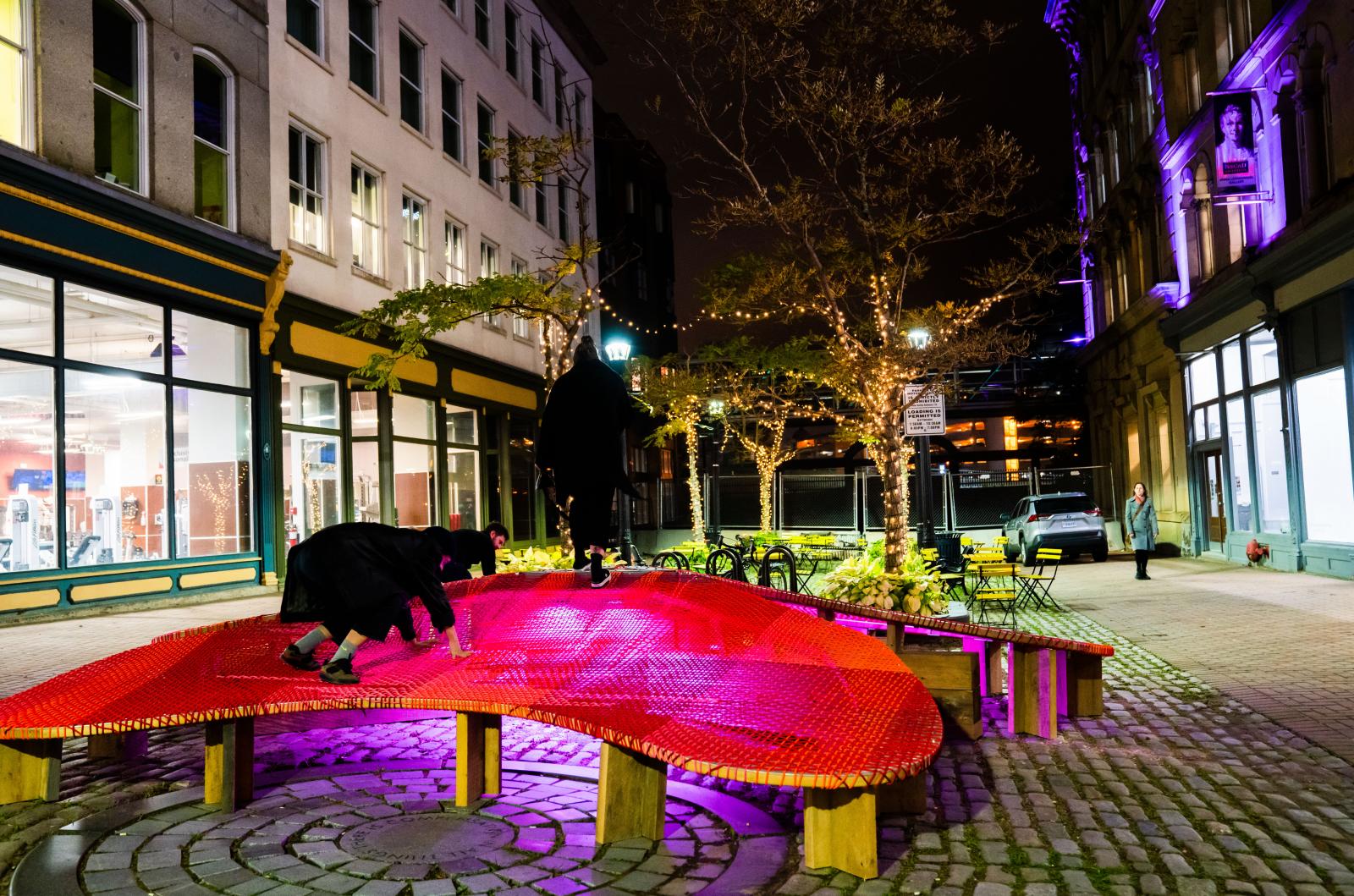
At night, visitors climb atop of The Blooming Seating’s luminous petals
Photo Credit: Joyce Liu, Lumi Studios
Weaving together textiles and functional art, The Blooming Seating designed by OSO planning + design creatively fulfills the need for colour, illumination, and pedestrian infrastructure. Sit down, lounge, or climb up top: found in Downtown Halifax’s pedestrian zone of Granville Mall, the public art installation’s “petals,” woven from yacht braid that recalls Halifax’s harbour culture, serve as seating and entertainment, a space of rest and play. At nighttime, coloured light plays on the woven braids. In colder months, the petals of this adaptive art piece lift up into a flowerbud, revealing the benches below.
2. Upcycle by Javid Jah
Toronto, Ontario
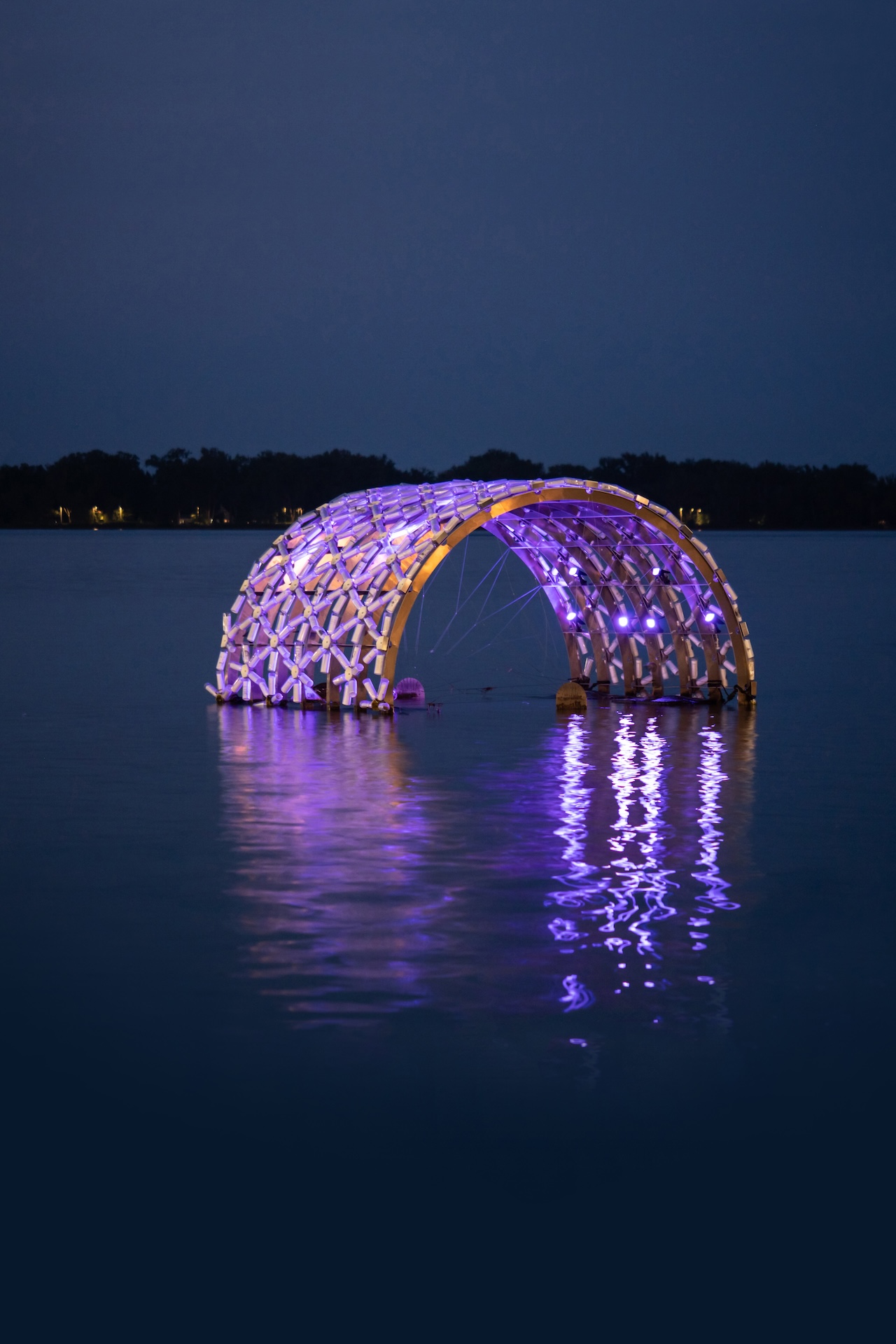
Light from Upcycle plays on the water’s reflective surface
Photo Credit: Michael Nguyen
What can the water tell us? Just look to the harbour. Floating along Toronto’s Waterfront, Javid Jah’s sculpture Upcycle reminds us that the water is a part of our cityscape and urban life. The streets are not the only possible sites for creative placemaking: out on the water is another canvas. This glowing, cylindrical sculpture sustainably reuses 456 plastic water bottles, each one containing a crowd-sourced story of personal connection to the water, which can be accessed through a web app.
Through its water stories and sustainable sourcing of artistic material, Upcycle allows you to contemplate your spiritual relationships to the water and consider your impact on the aquatic environment. These stories also reflect the persistent injustices surrounding water access, such as the lack of clean water in many Indigenous communities.
3. ART on the MART
Chicago, Illinois
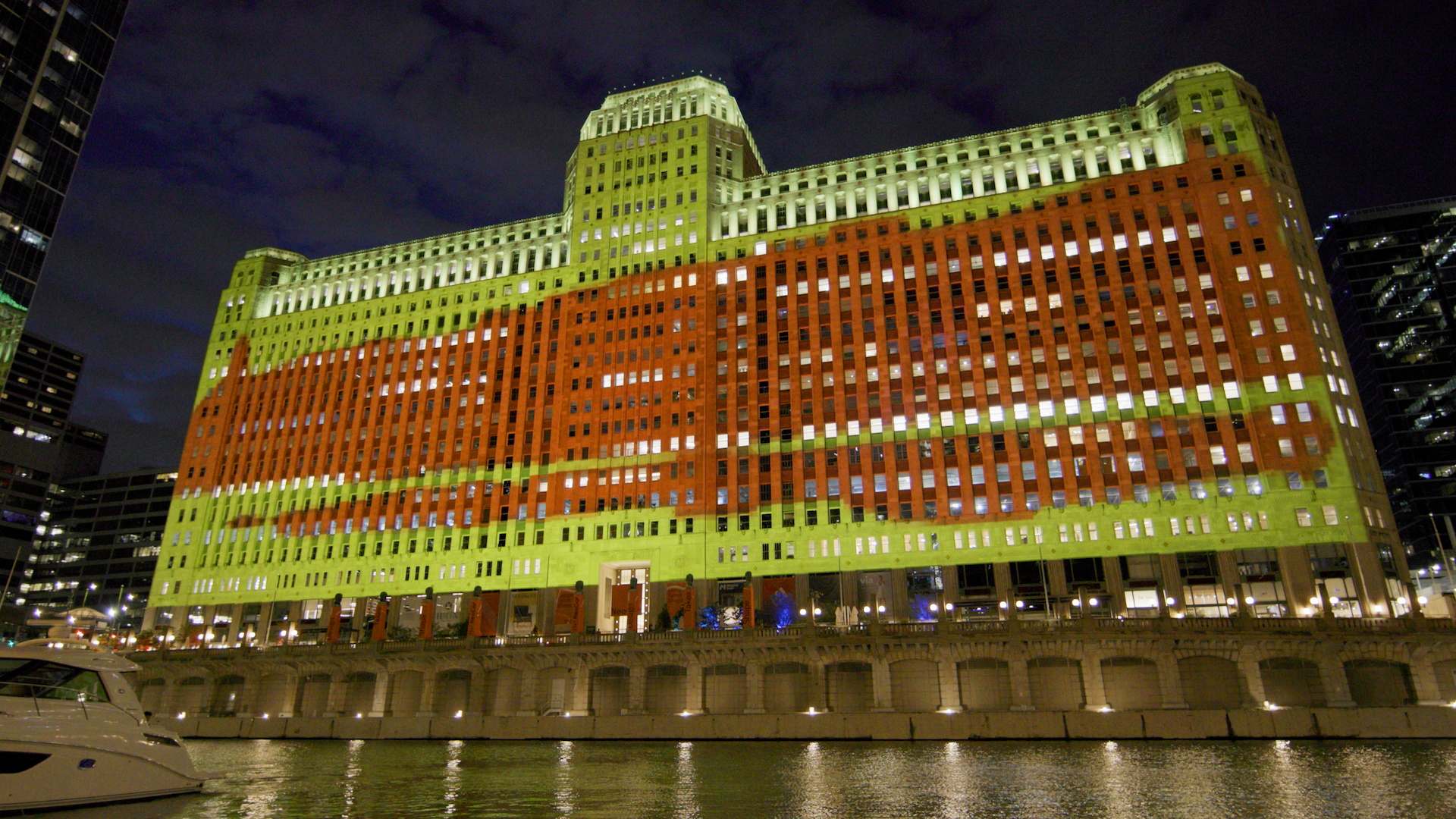
Nighttime by the Chicago River, ART on THE MART puts on Water, Wind and Fire, created by Cory Arcangel
Photo Credit: ART on THE MART
In this creative city, cutting-edge projection technology transforms even an architectural facade into a public art canvas. Using video mapping techniques, ART on THE MART displays projections of digital art on the 2.5-acre facade of the Merchandise Mart, an iconic downtown Chicago landmark. Boasting one of the world’s largest digital art platforms, ART on THE MART’s nightly shows bring together visitors and locals to share a range of audiovisual experiences of Chicago art and culture—from a celebration of Black dance to an homage to the Chicago band Earth, Wind, & Fire.
4. テンサイ (Tensai) by Cindy Mochizuki and Kelty Miyoshi McKinnon
Winnipeg, Manitoba
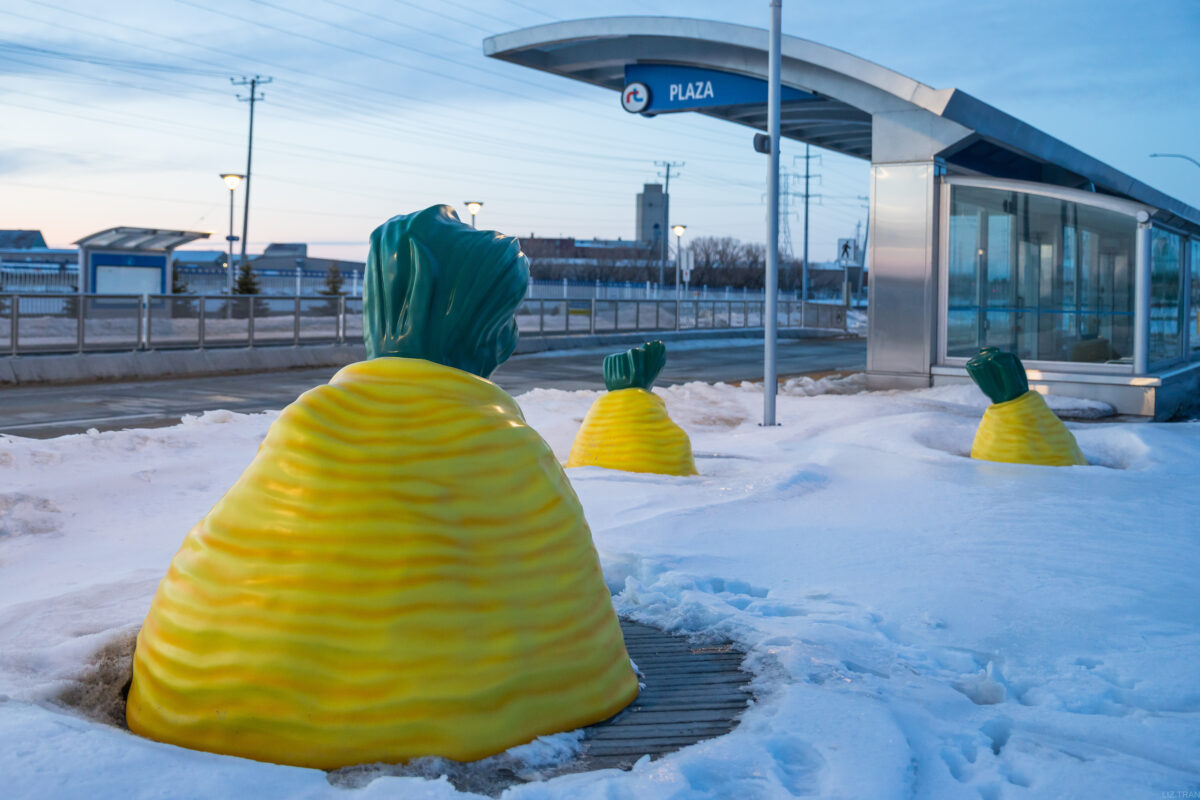
Sugar beets of テンサイ (Tensai) emerging out of the winter snow
Photo Credit: Liz Tran
Located at Plaza station next to the historic Manitoba Sugar Company factory, テンサイ (Tensai), named for the Japanese word for “sugar beet,” suggests a Zen garden. Beyond their sweet appearances, these sculptures by Cindy Mochizuki and Kelty Miyoshi McKinnon (PFS Studio) unearth a grim and often overlooked chapter of Canadian history.
During World War II, Japanese Canadian families were forcibly displaced, and many of them faced a difficult choice between hard labour on sugar beet fields or separation from their loved ones. テンサイ (Tensai) memorializes those struggles in a peaceful public space of vibrant sculptures, allowing us to contemplate Japanese Canadian resilience and artistry. The bright yellow sugar beets evoke the dessert wagashi, a traditional Japanese confectionary art form.
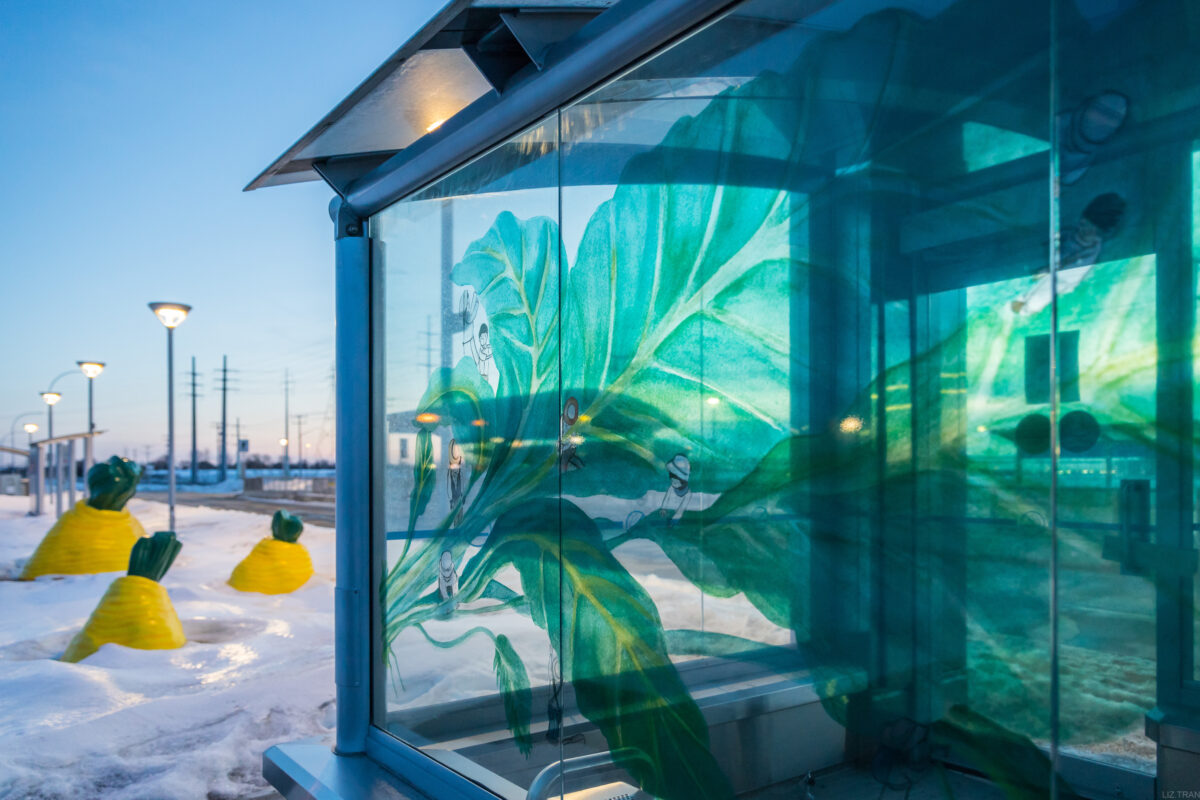
Adorning the windows of Plaza station, human figures are at work on sugar beet leaves
Photo Credit: Liz Tran
5. Tournée des Gonflables by MURAL
Touring Across Quebec
Reusable, easy to transport, and eye-catching, inflatables are a playful and adaptive addition to the creative city landscape. Tournée des Gonflables, a project by Montreal arts nonprofit MURAL, is a collection of five giant inflatable artworks depicting charming cartoon characters, from a canine saxophonist to an anthropomorphic pineapple. Designed by five different Quebec artists, these inflatable sculptures spread whimsy and colour as they tour across Quebec. Tournée des Gonflables shows the potential of inflatables as a temporary form of public art, creating ephemeral yet memorable cultural experiences.
6. Garden of Communities by Hello Wood
Budapest, Hungary
Video Credit: György Palkó
Juxtaposing geometric architecture and natural greenery, Garden of Communities is a unique monument that speaks to the vibrant culture of the Veszprém-Balaton region in Budapest, Hungary. Designed and constructed by Hello Wood, the installation is composed of 116 unique planters. Each planter symbolizes a municipality that participated in the Veszprém-Balaton 2023 Capital of Culture program, carrying the municipality’s name and a sapling.
Garden of Communities is a powerful visualization of the creative possibilities of collaboration between cities and communities. A vast spiralling tower upon a pavilion, the space invites reflection upon the memories tied to each village and city included, showcasing the innovative intersection of nature and public art. The plan is for the saplings to return eventually to their designated municipality, and once planted, the growing trees across the region will forever symbolize intercity unity.
7. Directions to Nowhere in Particular: A collaboration between The Bentway and From Later with design by Dreamside Digital
Toronto, Ontario
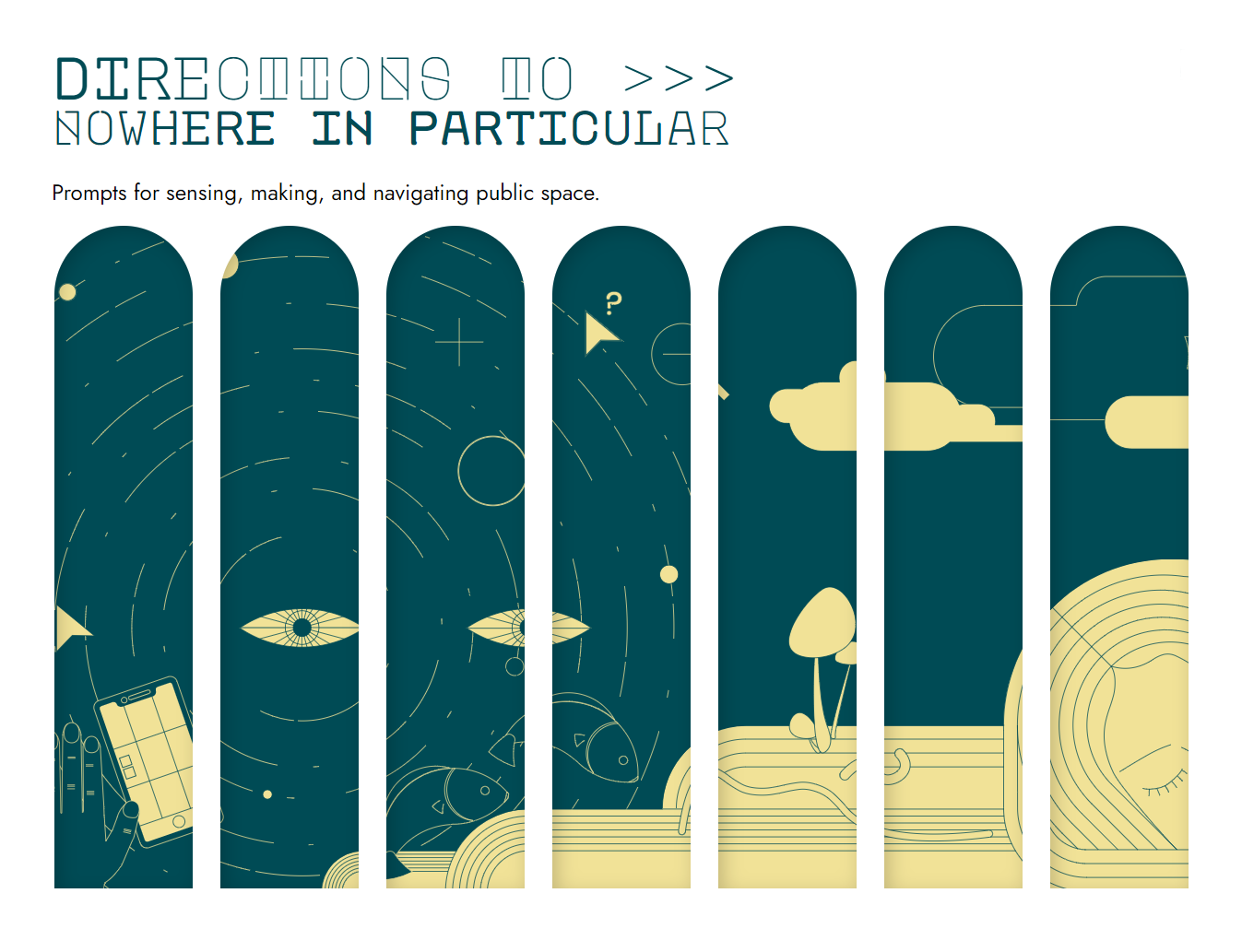
A screenshot of the app explores doorways into mindful public wanderings
Often find yourself glued to your phone screen while in public? Using the digital landscape to its advantage, Directions to Nowhere in Particular, a creative city project part of The Bentway’s Digital and/as Public Space Initiative, is a collaboration between The Bentway and From Later with designs by Dreamside Digital (formerly Nomadic Labs). By accessing the web app, users select prompts that come with directions for interacting with your surroundings (for example, “Make a tour guide-style voice recording describing what’s all around you and exchange with a friend”). Directions to Nowhere playfully challenges our conceptions of public spaces and how we navigate them, asking us to (mis)use our digital tools for our own discovery.
8. He Was on a Ride to a Safer Place by Gillie and Marc
Toronto, Ontario
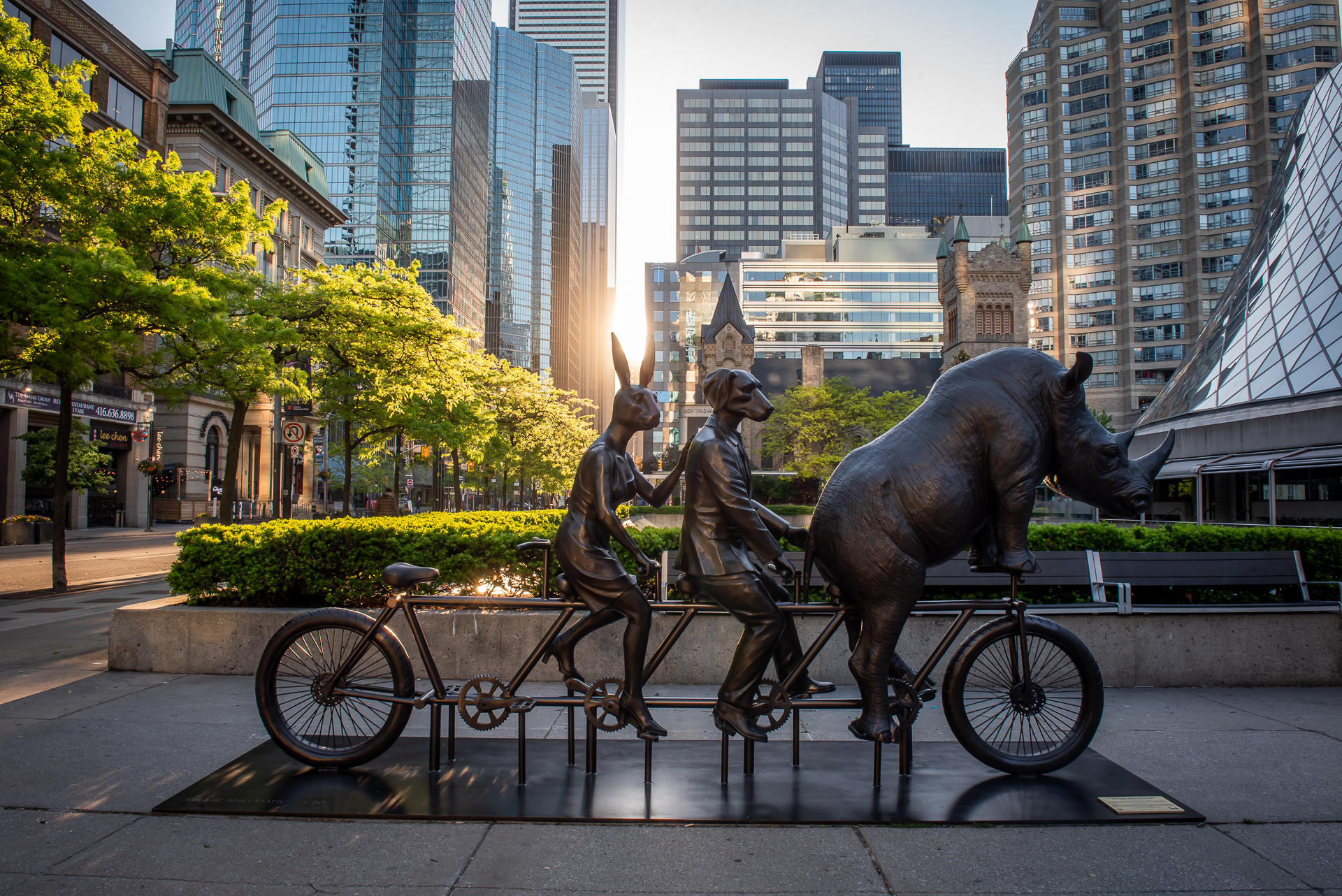
Rabbitwoman, Dogman, and a northern white rhinoceros on a bicycle in David Pecaut Square, backlit by the sun
Photo Credit: Hector Vasquez
In a creative city like Toronto, sometimes it’s easier to ditch the car and get to your destination by foot—or bicycle. He Was on a Ride to a Safer Place is a 3,000-pound bronze sculpture by internationally renowned artistic duo Gillie and Marc that invites you to claim the fourth seat on the ride.
The quad tandem bike encourages reflection on themes of equality, acceptance, and animal conservation with Gillie and Marc’s beloved characters, Rabbitwoman and Dogman. So, whether you need a second to reflect (or you’re looking for a fun photo-op), you can find this public art installation hosted by the Toronto Downtown West BIA at David Pecaut Square.
9. Pianos on the Streets by Pacey’s Pianos
Created by Pacey’s Pianos in collaboration with various local artists, this public art project is all about letting the world be your stage. Pianos on the Streets populates the streets of Vancouver with painted pianos, ready for those brave enough to sit down and play. Whether you tap a single note or show off full-fledged arrangements, each time music fills the surrounding air, it is a show of connection, inspiration, love, and joy. As interactive public art, these pianos become a site of expression, creating a sense of community among both friends and strangers.
10. Tsa Tsa Ke K’e – Iron Foot Place by Alex Janvier
Edmonton, Alberta
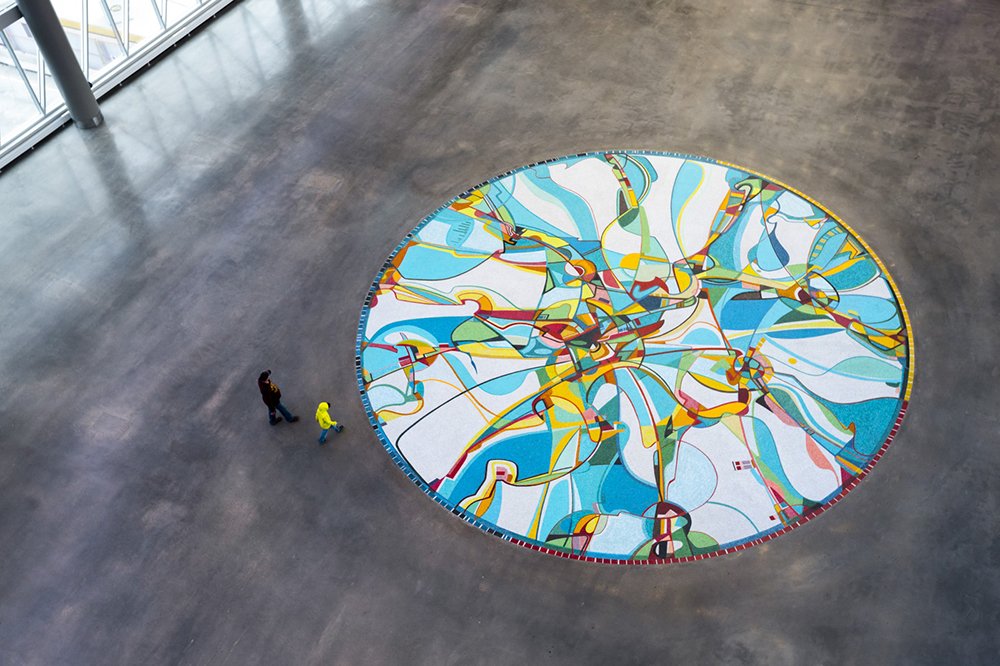
Tsa Tsa Ke K’e – Iron Foot Place is an immense span of vivid glass against grey flooring
Photo Credit: Dwayne Martineau, Laughing Dog Photography
Located at the heart of Edmonton’s Rogers Place Arena, Tsa Tsa Ke K’e – Iron Foot Place is a 1500-square-foot glass smalti mosaic that celebrates the land and its connections to Indigenous history. Created by the late Alex Janvier, one of Canada’s pioneering Indigenous artists, the painting uses colours to represent the natural elements: the blue skies, winter snowfalls, the lush flowers, and farming of the spring. Through the colours and organic abstract shapes, the piece tells a story of how the local land of Edmonton has remained a gathering place over the years and how it interacts with those who reside upon its grounds.
Past Creative City Projects
2023 List of Inspirational Projects
- Musical Swings by Daily Tous Les Jours (Touring)
- Orchard by Diane Borsato
- Mashup Pon Di Road by Bahia Watson and Liza Paul
- Roseaux by 1ToMn (One Touch of Madness) in collaboration with UDO Design and Serge Maheu
- Joy by Rita Letendre
- Interactive Light Installations by Iregular Studio
- Daughters of the Diaspora by Destinie Adelakun
- Breathing Lights by Adam Frelin
- Nocturne: Art at Night by Nocturne Festival
- Monsters for Beauty, Performance and Individuality by Duane Linklater


